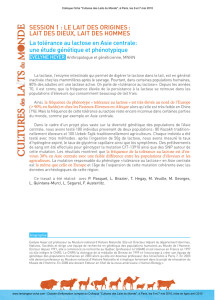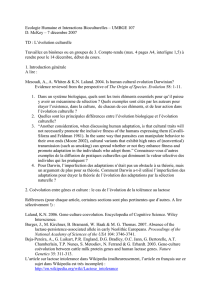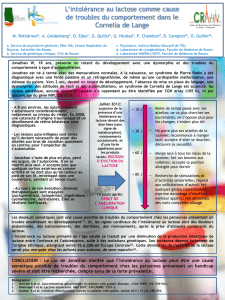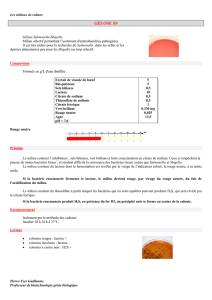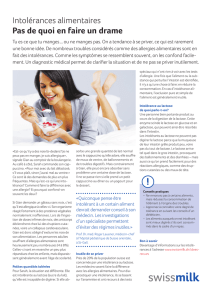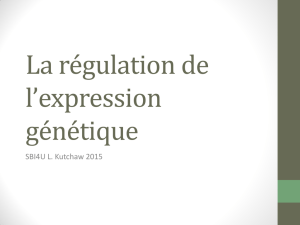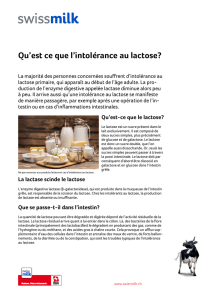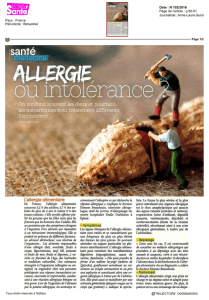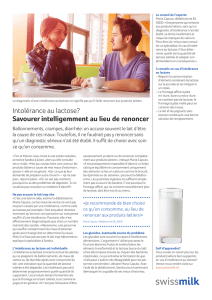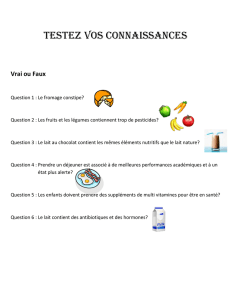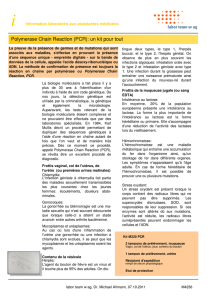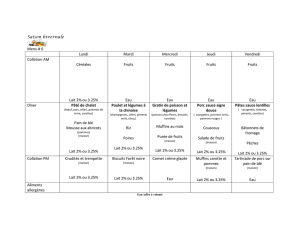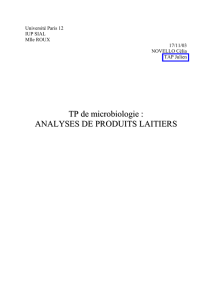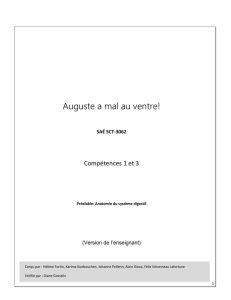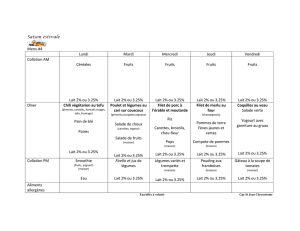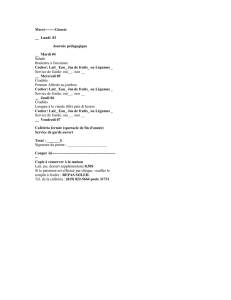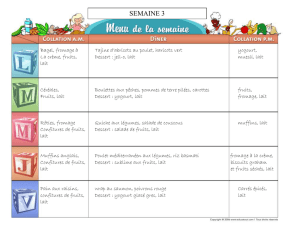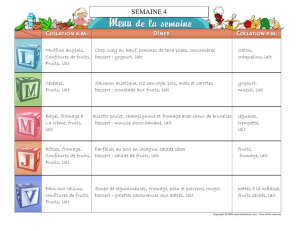Effet des bactéries lactiques locales du yaourt sur l
publicité
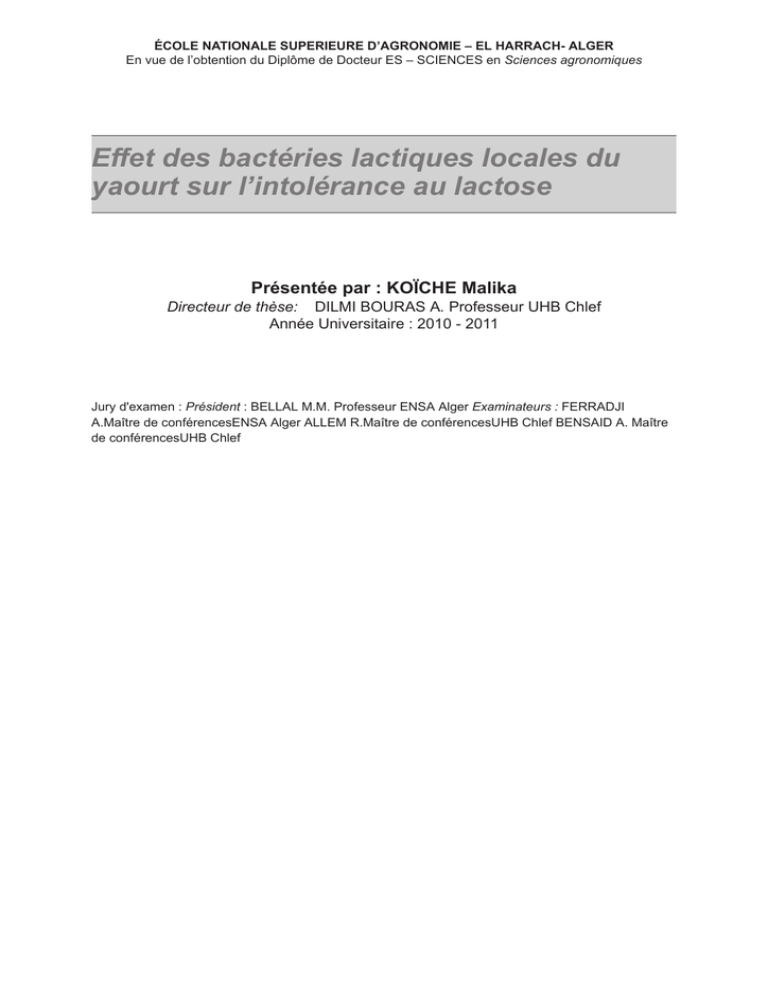
!"#$%
&#'($)
(*$(
+,
-(
./01
&*
++2
3
435$$$6
73-#*6
839:)'-#*6
;3<#56*$6#'-#*6
=356($6&$6#6>$?-'-#*6
@3A>$*6A$'-#*6
3
43#$
73#$5$*$6'#B>#*6$'
83*$$#
;3*$A$#*$?-
3
43$6$?-
735$$$6
83$>$'#(#&6$6
;3-
=3**#$$?--$$6#'#$6#*-#*6
@39(<($>'#$6#*-#*6
C3'$>6$*'#$6#*-#*6
D3$55*##>$$6#*
,3+2
43#$
73$>$&$'&*$#*$?-
836$>#
;3+*$#*$?-'-96-
E
4 A#*'#$6#*-#*6'#>$6':#5
7 43
73
8 43
73
4 -''#A#*'#$6#*-#*6'#>$6':#5
7 436#(F$'$5$*$6**$$6'
!
"#!"
73$&#>'6-*:6-$6'-96-
83-A$'&*$'-96-''*6'$$6GH($(-#'-&'$>$5
8 43-A$'5(#*$?-'#-&'$>$5'-#$
73A#-$6'#*$A$#*$?-'-#$
83$#$$6'-96-#6*##$6#-#*6I$-#:-($J
K
++2
E
55'&*$#*$?-#6*#'-96--#$6#*-#*6
(*$(
Le mérite de ce travail, réalisé au laboratoire de bioressources naturelles locales à l’université
Hassiba Benbouali de Chlef, revient à toutes les personnes qui ont participé de près ou de loin à sa
réalisation par leurs encouragements et leurs aides, et aux quelles d’ailleurs j’exprime ma profonde
reconnaissance.
La réussite de ce travail ne saurait être possible sans le grand apport de mon directeur de
thèse, Mr. Dilmi Bouras A., Professeur à l’université Hassiba Benbouali de Chlef. Je le remercie de
m’avoir offert l’opportunité de réaliser ce projet au sein de son équipe, pour ses conseils précieux,
ses orientations scientifiques, sa disponibilité ainsi que son optimisme affiché malgré toutes les
contraintes, pour la confiance qu’il m’a témoigné le long de la réalisation de ce travail, pour son
encadrement tant apprécié assuré pendant la rédaction de la thèse, sa rigueur scientifique, ses
encouragements et ses conseils judicieux. Je n’oublierais jamais que ma formation dans ce domaine
lui est redevable. Le mot « Merci » ne suffira jamais pour lui exprimer ma profonde et éternelle
gratitude.
Mes vifs remerciements s’adressent également Mr. Bellal M.M., Professeur à l’école nationale
supérieure d’agronomie d’Alger, pour avoir accepté la lecture du manuscrit, et la présidence du
jury, en dépit de ses nombreuses occupations, en m’apportant ses observations et ses critiques.
Que Mr. Ferradji A., Maître de conférences à l’école nationale supérieure d’agronomie
d’Alger, à qui j’ai eu le privilège d’avoir comme directeur de thèse pour mon magister, trouve
entre ces lignes l’expression de ma profonde gratitude d’avoir accepté de siéger parmi ce jury et
de faire part de ses remarques.
J’adresse aussi mes remerciements à Mme. Allem R., Maître de conférences, à l’université
Hassiba Benbouali de Chlef, pour ces qualités humaines, ces encouragements, ces suggestions
pertinentes, ainsi que je la remercie aimablement pour avoir bien voulu juger ce travail.
Mes remerciements vont aussi à Mr. Bensaid A., Maître de conférences, à l’université Hassiba
Benbouali de Chlef, pour ses conversations scientifiques et ses encouragements, je le remercie aussi
d’avoir accepter de faire partie de ce jury et d’examiner ce travail. Ces remarques et suggestions
ne feront que perfectionner ce manuscrit.
Ce projet n’aurait pu être une réussite sans la contribution, directement ou indirectement, de
plusieurs personnes en l’occurrence:
Professeur Arroume N., du Laboratoire BIOGEM de l’université Lille 1, France, à qui je dois
une reconnaissance toute particulière pour son aide et ses directives.
Dr. Sebaihia M. Maître de conférences, à l’université Hassiba Benbouali de Chlef à qui
j’exprime mes vifs remerciements pour son aide ainsi que sa contribution scientifique et efficace.
Je n’oublierai évidemment pas de remercier toutes les personnes auxquelles revient le mérite
de ma formation ainsi que toute ma famille et mes amies pour leur soutien moral.
Enfin je n’oublierai pas de dire merci à tous ceux qui ont partagé avec moi les moments les
plus difficiles de la réalisation de ce travail, et tous ceux qui m’ont souhaité bon courage.
+,
+,
55'&*$#*$?-#6*#'-96--#$6#*-#*6
-(
L’étude porte sur l’isolement et l’identification de Streptococcus thermophilus et Lactobacillus
bulgaricus locales, à haut pouvoir de dégradation de lactose d’une part, et d’autres part sur le test
de la résistance, de la croissance et de l’activité de ces bactéries. Les souches et les cultures mixtes
ayant dégradé des quantités importantes de lactose (supérieur à 80 %) et qui ont gardé une bonne
viabilité (supérieure à 107 cellules / mL) sont mises dans des conditions extrêmes du tube digestif.
Les résultats ont montré des variations considérables entre genres, espèces et souches de la même
espèce dans la dégradation du lactose en cultures pures et en cultures mixtes ; ainsi qu’à croître
à différents pH en absence et en présence de sels biliaires. Les résultats de l’expérimentation sur
les lapins confirment ceux trouvés in vitro, car l’ingestion des yaourts YSLB1, YSLB2 et YSLB3
conduit à une présence des bactéries au niveau des différentes parties du tube digestif, pendant
une durée et avec un nombre appréciable de bactéries. Ce nombre reste important tant que les
lapins consomment les yaourts. Après arrêt de la consommation, les bactéries restent vivantes
dans l’estomac, dans le duodénum et dans le gros intestin à des taux supérieurs à 107 cellules /
mL pendant 4 jours mais disparaissent après 6 jours. L’ingestion des yaourts YSLB1, YSLB2 et
YSLB3 a nettement amélioré l’activité lactasique chez les lapins. Le lot des lapins recevant 3x5
mL de lait à 12 % d’EST et 3x5 mL du YSLB1 par jour, pendant deux semaines, présente une
activité lactasique six fois plus importante que celle du lot témoin.
L’étude de la prévalence de l’intolérance au lactose chez des enfants de moins de 3 ans a
révélé la présence de 28.22% de cas d’intolérants au lactose et celle des adultes(280 étudiants
volontaires), soumis un régime alimentaire incluant 2x150 mL de lait / j, a montré que 43,92
% ingèrent le lactose sans aucun symptôme après 7 jours de consommation ; alors qu’ils
étaient 35% au début de l’expérimentation. Les 8.92 % des cas ayant présenté des symptômes
d’intolérance au lactose ont repris leurs activité enzymatique après avoir réintégrer le lait dans leurs
régime alimentaire.Ces derniers représentent donc une intolérance secondaire, alors que 56.07 %
présentent toujours plusieurs symptômes d’intolérance qui peut être primaire ou congénitale. Par
ailleurs, Les intolérants au lactose (56.07 %) ont été soumis à un régime alimentaire enrichi en lait
et en yaourt local YSLB1 (RS + LAIT + YSLB1) et au bout de 7 jours de consommation, 71.33
% ont retrouvé leurs activité lactasique, renforcée par la lactase des bactéries de YSLB1, alors
que 28.66 % n’ont pas pu retrouver une bonne activité et qui sont probablement des intolérants
congénitaux ou primaires sévères.
Mots clés : Survie, tube digestif, lapin, Yaourt, activité lactasique, bactéries lactiques
extrêmophiles, intolérance au lactose, lactose.
./01
./01
55'&*$#*$?-#6*#'-96--#$6#*-#*6
&*
The aim of this study concerned the isolation and the identification of local strains of Streptococcus
thermophilus and Lactobacillus bulgaricus , with have a high capacity to degrade lactose on the
one hand, and other share to test resistance, growth and activity of these bacteria. Strains and mixed
cultures having degraded significant quantities of lactose (higher than 80 %) and which kept a good
viability (superior than 10 7 cells/mL), are subjected to extreme conditions of the digestive tract.
The results showed considerable variations between genera, species and strains of the same species
in the degradation of lactose in pure and mixed cultures like growing with pH different in absence
and in the presence of bile salts. The results of the experimentation on rabbits confirmed those
found in vitro, because the ingestion of yoghourts YSLB1, YSLB2 and YSLB3 led to a presence
of the bacteria on the level of the various parts of the digestive tract, for one length of time and with
an appreciable number of bacteria, this number remains significant as long as the rabbits consume
yoghourts. After stop of consumption, the bacteria remain present in the stomach, the duodenum
and the large intestine aerates superiors with 10 7 cells/mL during 4 days but disappear after 6 days.
The ingestion of yoghourts YSLB1, YSLB2 and YSLB3 clearly improved the lactase activity in
rabbits. The rabbits group receiving 3x5 mL of milk to 12 % and 3x5 mL of the YSLB1 per day
have the best result with a lactase activity six times more significant than that of the control group
having a standard mode after two weeks of consumption of yoghourt.
The study of the prevalence of intolerance to lactose in the children of less than 3 years
revealed the presence of 28.22% cases of intolerance to lactose, and that of the adults (280 voluntary
students) who were subjected to one diet including 2x150 mL/day of milk showed that 43.92 %
introduce lactose without any symptom at the end of the 7 th day of the test, whereas they were
35% at the beginning of the experimentation. The 8.92 % cases having presented symptoms of
intolerance at lactose took again their enzymatic activity after having to reinstate milk in their
diet; they represent a secondary intolerance, whereas 56.07 % always present several symptoms of
intolerance which can be primary or congenital intolerance. The intolerant ones at the lactose (56.07
%) were subjected to a diet enriched with milk and local yoghourt YSLB1 (SD + MILK + YSLB1)
and at the end of 7 days of consumption, 71.33 % found their lactasic activity, reinforced by
bacterial lactase of YSLB1, whereas 28.66 % who could not find a good lactasic activity in 7 days
of consumption of the bacteria of yoghourt are probably severe primary or congenital intolerant.
Key words: Survival, digestive tract, rabbit, yoghourt, lactase activity, lactic acid bacteria,
extrêmophile, intolerance to lactose, lactose.
!
55'&*$#*$?-#6*#'-96--#$6#*-#*6
++2
++2
3
435$$$6
$%&
"
#
#"$%& #
&"'
()**)&
55'&*$#*$?-#6*#'-96--#$6#*-#*6
$'&+
#
",()**)&
73-#*6
743#'$55#$
++2
&- ..
"/&
6-*
773#'$556'-$#$$
&#- -#*6'$*$-G6'-$#$$L
55'&*$#*$?-#6*#'-96--#$6#*-#*6
6-* 839:)'-#*6
$(&#
"0
()**$&
++2
;3<#56*$6#'-#*6
=356($6&$6#6>$?-'-#*6
=L439'6#9'-#*6
=L73&6#$(:9'6#9M9($?-
55'&*$#*$?-#6*#'-96--#$6#*-#*6
=L83K($6#*$?-
++2
$)&+
1
"!..&"2!($334&
@3A>$*6A$'-#*6
@L43A>
55'&*$#*$?-#6*#'-96--#$6#*-#*6
=L73*6A$
++2
3
43#$
73#$5$*$6'#B>#*6$'
83*$$#
55'&*$#*$?-#6*#'-96--#$6#*-#*6
$*
"5()**$&
8L43<#'-#*6'#N$'-*$6'##*
8L73*$6'##*
++2
$+&,
",+
;3*$A$#*$?-
($367&
55'&*$#*$?-#6*#'-96--#$6#*-#*6
$,&!!898!
1
.
"5()**$&
;L435#-*'():9$*6*:$($?--#N*$A$#*$?-
;L4L43(-
:#!#
;L4L73
++2
#
,
:#!#
.
;L4L83$-G
3
43$6$?-
735$$$6
55'&*$#*$?-#6*#'-96--#$6#*-#*6
83$>$'#(#&6$6
; <
++2
;3-
;L435$*$*6>$##*
;L735$*$*6'$#*
;L835$*$$($#*6-:96#*$'9'-#
55'&*$#*$?-#6*#'-96--#$6#*-#*6
&#- $$6'#:96#*$'9'-#'#6-#$6:-($'-#
O'$55>6-:$?-L
6-*
&#-, A#-$6'-6-*>''-#$''5$*$*$($#*'
'$5596->$6L
++2
6-*
=3**#$$?--$$6#'#$6#*-#*6
=L43*6?-*:9$6#6>$?-'#$6#*-#*6
55'&*$#*$?-#6*#'-96--#$6#*-#*6
$-
"()**6&
++2
$.&
! =
1
>
.
"5()**$&
=L73$(A$6
55'&*$#*$?-#6*#'-96--#$6#*-#*6
=L7L43#$(O$A$#>$
=L7L73#$(OA$
@39(<($>'#$6#*-#*6
C3'$>6$*'#$6#*-#*6
++2
D3$55*##>$$6#*
,3+2
43#$
55'&*$#*$?-#6*#'-96--#$6#*-#*6
73$>$&$'&*$#*$?-
836$>#
8L43*)(6:6#6>$?-
*6?-I*6**$J
&*$##
8L73*6#6>$'&*$#*$?-
;3+*$#*$?-'-96-
++2
;L436*6**-#$A$-L:(6:$#-
;L4L436:6#6>$
(
;L4L73*):9$6#6>$?-
?
;L4L83*)-$$6#
;L4L;3*)&$6*:$($?-
;L73*6&*$##-'#&-*%$$L&-#>$*-
;L7L436:6#6>$
?
(
55'&*$#*$?-#6*#'-96--#$6#*-#*6
;L7L73*):9$6#6>$?-
;L7L83*)-$$6#
;L7L;3*)&$6*:$($?-
(
;L83&6#$('-#*6-*6-'#5($6
;L8L43&6#$('-#*6*:M
/
!0
?
?
;L8L73&6#$('-#*6*:M6*6**-6#$A$-L
:(6:$#-
!
;L8L839>$'5('-96-
++2
!
?
? !
$%1&
.
"
($33%&
;L;3-A$'5('-96>6-'#-&'$>$5
!
(
? 55'&*$#*$?-#6*#'-96--#$6#*-#*6
( (
!
;L=3<#'&*$#*$?-'-96-
;L=L43<#*:6#6>$?-
++2
;L=L73<#-$$6#'$$?-
;L=L7L4355-##6>A$
;L=L7L7355-#$-#5#6$$#
@
55'&*$#*$?-#6*#'-96--#$6#*-#*6
;L=L7L836'-*$6'&*$6*$
(
)
(
#
A
( (
(
-
A
#
;L=L7L;3-$6''$:
00
5!
?
A..
;L=L7L=355-#6$((-$$
++2
;L=L7L@3<#$-(-
;L=L7LC355-#*6$$6&$>
A.
;L=L7LD3#$5#-*-#&6$6'-*#*$-('($-G
;L=L7LP35#-*-#*:6#6#($
!!
!
55'&*$#*$?-#6*#'-96--#$6#*-#*6
;L=L7L4Q3'$>$&$#$'-#$
!
? (
&#-, -#'G$**6($A#96-#$-#$6#*#*6L
++2
IRJ
IJ
(
55'&*$#*$?-#6*#'-96--#$6#*-#*6
E
4 A#*'#$6#*-#*6'
#>$6':#5
!
!!
E
+$$+;-B52;02'2C"D
&
7 43
4L43$*-
55'&*$#*$?-#6*#'-96--#$6#*-#*6
$%'& !
!
4L73$6-'
4L83K#6$$#
!
4L;3$#$-G'$6#(
!
E
?
4L=3*$5*:$($?-
73
7L43#9($*6&$6#6>$?-
7L4L436#(
? !
55'&*$#*$?-#6*#'-96--#$6#*-#*6
$%(&;
. !
C E
$%)&;
.
?
7L4L73'$5$*$6-$5$*$6
7L736>'-#*6
55'&*$#*$?-#6*#'-96--#$6#*-#*6
7L836-A6$*$'$5$
E
N*$'$6$*S4QQQ,34QQS4Q,'>6$*L
7L;3,$&$#$'&*$
7L=3-A$'&*$'#*6'$$6GH('--&'$>$5
*6'$$6'*6$*
55'&*$#*$?-#6*#'-96--#$6#*-#*6
!
!
!!
8 43
4L43$
E#
4L73$
E
4L83T6-
2 4L;3*$5$##>
73
7L43-A$'&*$'#-&'$>$5'-#$
7L4L43#)A('-#$?-$'>$?-
!
55'&*$#*$?-#6*#'-96--#$6#*-#*6
7L4L73#)A('-#$?-$''-6'#
7L4L83#)A('5)*
7L4L;3#9($*6&$6#6>$?-
7L73A#-$6'#'N$6#*-#*6*:M##$#6#U>
7L7L436$-$6'#6G$(-G
E
&#-, >$(''$55>6-'#$56*$6'-(L
( 4
7 8
7L7L73$*$6'#$
7L83(#$6$6'#*$A$#*$?-'-#$
6
V4
6
V7
6
V8
6 V;
55'&*$#*$?-#6*#'-96--#$6#*-#*6
7L;3(#$6$6'#*$A$#*$?-*:M#:-($
!
!!
7L=3#9$$?-
4 -''#A#*'#$6#*#*6'#>$6':#5
$%*&!
.
!
F G#-.)**%H)**I
55'&*$#*$?-#6*#'-96--#$6#*-#*6
$%+5 )**%H)**I
$%,5 !
F !
)**%H)**I
&#-, *$$?-'A6#6$
&#-, 9(<($*:M#A6#6$)#$'-#$L
55'&*$#*$?-#6*#'-96--#$6#*-#*6
!
!!
7 436#(F$'$5$*$6**$$6'
!
"#!"
&#-E *)(6:6#6>$?-F:9$6#6>$?-&$6*:$($?-'6-*:$6#'
' !
"#!"
0
73$&#>'6-*:6-$6'-96-
7L43>'$6'-#*6
7L4L43*6$$$#'-#$
!
? 7L4L73>'$6'-#*6#*-#--
L
J 55'&*$#*$?-#6*#'-96--#$6#*-#*6
J
4
$%-&!
H4IK- !
. J
)
!
)
J
$%.&!
H4IK- ?
. 7L4L83>'$6'-#*6#*-#-($G
T+ 4 4
L )
T+ 7 J L J
T+ ; 4 L J
T+ 8 % L %
T+ = J L )
55'&*$#*$?-#6*#'-96--#$6#*-#*6
$'1&!
H4IK-
7L736-A6$*$'$5$
7L7L43*$'$$$$#'-#$
7L7L736-A6$*$'$5$*-#--
J
4
J
4
$ 7 $'%&!8H4IK-
!
!
. 4
J
4
J
$''&!8H%K-
!
!
. !
55'&*$#*$?-#6*#'-96--#$6#*-#*6
$
7
J
J
7
$'(&!8H4IK-
?
$ J J
$')&!8H%K-
?
7L7L836-A6$*$'$5$-#-($G
!
55'&*$#*$?-#6*#'-96--#$6#*-#*6
$'*&!8H
4IK-
#
. ?
/ !
? J
J
J
!
J
$'+&!8H
%K-
#
. 7L83,$&$#$'&*$'-96-#6*#
7L8L43,$&$#$'&*$*-#--
7
J % J
%
55'&*$#*$?-#6*#'-96--#$6#*-#*6
$',&!
H4IK-
!
.
. %
J
7
$
$'-&!
H%K-
!
.
. !
!
? !
$
$
)
)
$'.&!
?
H4IK-
.
. ? 55'&*$#*$?-#6*#'-96--#$6#*-#*6
$(1&!
?
H%K-
.
. 7L8L73,$&$#$'&*$*-#-($G
$(%&!
.
#
H4IK-
"L#&. "#
&
!
!
55'&*$#*$?-#6*#'-96--#$6#*-#*6
$('&!
.
#
H%K-
"L#&. "#
&
83-A$'&*$'-96-''*6'$$6GH(
$(-#'--&'$>$5
$((&!
.
#
H B)J
55'&*$#*$?-#6*#'-96--#$6#*-#*6
$()&!
.
#
H B%J
$(*&!
.
#
H B7J
$(+&!
.
#
H B7J *4M
.
55'&*$#*$?-#6*#'-96--#$6#*-#*6
J
4 L J L
% L %
8 43-A$'5(#*$?-'#-&'$>$5'-#$
!
!!
4L43A6#-$6'&*$'#6(*
(
$(,&2
.
# N
"37
&
#
OA$(OA)OA4"PN
&
(
55'&*$#*$?-#6*#'-96--#$6#*-#*6
(
4L73A6#-$6'&*$'#'-6'-(
$(-&2
.
# N
"37
&
#
OA$(OA)OA4"PN
&
!
55'&*$#*$?-#6*#'-96--#$6#*-#*6
4L83A6#-$6'&*$'#>6$$$('#5)*
(
$(.&2
.
N
"37
&
#
OA$(OA)OA4"PN
&
(
(
73A#-$6'#*$A$#*$?-'-#$
7L43($$6'#'$6#*-#*6*:M##$
55'&*$#*$?-#6*#'-96--#$6#*-#*6
W
$)1&==
1 .=9
7L73(#$6$6'#*$A$#*$?-*:M##$
55'&*$#*$?-#6*#'-96--#$6#*-#*6
$)%&'
=!
.
#"PN
&
$)'&'
=!
.
#"
N
&
83$#$$6'-96-#6*##$6#-#*6I$-
#:-($J
55'&*$#*$?-#6*#'-96--#$6#*-#*6
4 )
3&2
>
( (
# F
.
8
#OA$ 55'&*$#*$?-#6*#'-96--#$6#*-#*6
!! " ( (
" $ (
!
(
( (
(
!
55'&*$#*$?-#6*#'-96--#$6#*-#*6
K
++2
K
++2
ABSOLONNE J. (1989). Le yaourt : adaptation aux objectifs nutritionnels In "Lait
fermentés : Actualité de la recherche ". John Libbey eurotext itd, 153-159.
ACCOLAS J.P., BLOQUEOL R., DIDIENNE R. et REAGINIER J. (1977). Propriétés
acidifiantes des bactéries lactiques thermophiles en relationavec la fabrication du
yoghourt, Le lait, 1(23) : 561-562.
ACCOLAS J.P. (1979). Les levains thermophiles : propriétés et comportement en
thechnologie laitière. Congrés International : Microbiologie alimentaire, 110ctobre.
ACCOLAS J.P., HEMME D., MAZEAUD M.J., VASSAL A., BOUILLANE C., et VEAU
M. (1982). Les levains lactiques thermophiles : propriétés et comportement en
technologie laitière. Le lait, 49 : 346-352.
ADRIAN J. et LEPEN C.M. (1987). Lait : matière première de l’industrie laitière. Ed.
Tec. Et Doc., Lavoisier, Paris, 256P.
AKTYPIS A., KALANTZOPOULOS G., HUIS IN’T VELD J.H.J and TEN BRIND B.
(1998). Purification and characterization of thermo-philin T, a novel bacteriocin
produced by Streptococcus thermophilus ACA-DC 0040 . Journal of Applied
Microbiology, 84: 568-576.
AKTYPIS A., TYCHOWSKI G., KALANTZOPOULOS G. and AGGELIS G. (2007).
Studies on bacteriocin (thermophilin T) production by Streptococcus thermophilus
ACA-DC 0040 in batch and fed- batch fermentation modes. Antonie van
Leeuwenhoek, vol 92(2): 207-220.
ème
ALAIS C. (1975). Sciences du lait : principes et techniques laitières. 3
édition, Ed.
S.E.P.A.I.C., Paris, 324P.
ALAIS C. et LINDEN G. (1997). Abrégé de biochimie alimentaire. Ed. Masson , Paris :
167-182.
ALAIS C., LINDEN G. et MICLO L. (2003). Abrégé de Biochimie alimentaire. Vol.5,
Ed :Dunod, Paris, 213-234.
ALM L. (1982). Effect of fermentation on lactose, glucose and galactose content in milk
and suitability of fermented milk products for lactose intolerant individuals. J.Dairy
Sci., 65:346-532.
ALSTON MILLS B.P. (1995). Comparative analysis of milks for human consumption. In :
Hand book of milk composition. Acad. Press, New York: 828-834.
AMOROSO M.J., MANCADENARA M.C., DIVER G. (1989). The growth and sugar
utilization by Lactobacillus bulgaricus and Streptococcus thermophilus isolated from
market yoghourt, Le lait, 69: 519-528.
AMIOT J., FOURNIER S., LEBEUF Y., PAQUIN P., SIMPSON R. (2002). Composition,
propriétés physicochimique et techniques d’analyse du lait. In : Science et
55'&*$#*$?-#6*#'-96--#$6#*-#*6
technologie du lait, transformation du lait. Ed .Presse internationale polytechnique
fondation de technologie laitière du Quebec, INC Montréal, Canada, 324P. .
AMROUCHE T. (2005). Contribution à l’étude du pouvoir immunomodulateur des
bifidobactéries: analyse in vitro et étude ex in vivo des mécanismes moléculaires
impliqués. Th. Doctorat (Ph D), Université de Laval, Québec, 155P.
ANDERSON J.W. et GILLILAND S.E.(1999). Effect of fermented milk (yogurt)
containing Lb. Acidophilus L1 on serum cholesterol in hypercholesterolemic humains.
J. Am. Coll. Nutr., 18(1): 43-50.
ANDRIEUX C. et SAQUET E. (1983). Effects of microflore and lactose on the
absorption of calcium, phosphore and magnesium the hindgutof the rat. Report.
Nutr.Develop. 23 : 259-271.
ANTOINE, J.M ., FRIPPIAT, A.F ., (1986) : Le yoghourt : Nutrition et santé , Ed. Druco,
Halle- Belgique, 21-23.
ATKINSON R.L., KRATZER F.M. et STEWART G.F. (1957). Lactose in animal and
humain feeding . Rev. Int. J . Dairy Sci . 40 : 1114-1119.
AVALER D.M., POULTER M. et HOLLOX E.J. (2001). Intolérance au lactose et autres
sucres diététiques. Borguez Metabdispos. 29 :6-531. http://www. Medaspothai.org/
journal.
BEAL C., DESCHAMP N., JOUILLARD V., DE ROISSART H., RICHARD J et SARAUX
B. (1994). Cinétique de croissance et d’acidification des bactéries lactiques in
bactéries lactiques, Tome1, Ed. Lorica, Paris, 1-264.
BERGMIER D. (2002). Production des exopolysaccharides par fermentation avec des
cellules immobilisées d’un milieu de base de perméat de lactosérum. Th. Doctorat,
Univ.Laval, Quebec . http:// www.thèse aval.ca/auteurs.com.
BESNIER M.O., BOURLIOUX P., FOURNIAT J., DUCLUZEAU R. et AUMAITRE A.
(1983). Influence de l’ingestion du yaourt sur l’activité lactasique intestinale chez les
souris axéniques ou holoxéniques. Ann.Microbiology (Inst. Pasteur), 134 A: 219-230.
BERTAZZONI M.E., BENINI A., MARZOTTO M., SBARBATI A., RUZZENENTE O.,
FERRARIO R., HENDRIKS H., DELLAGLIO F. (2004). Assessment of novel probiotic
Lb. casei strains for the production of functional dairy foods. International Dairy
Journal, 14, 723 -736.
BHATNAGAR S. and AGGARWAL R. (2007). Lactose intolerance . BMJ ., 334 ,
1331-1332
BIANCHI-SALVADORI B., GOTTI M., BURGHERA F.and PALINELLI U. (1978).
Variations in lactic and bifidus flora in the intestine after administration of yogurt lactic
cultures. Le lait, 58: 17 - 42.
BIANCHI-SALVADORI B., CAMESSCHELLA P. and BAZZIGALUPPI E. (1984).
Distribution and adherence of Lb. bulgaricus in the gastrocentric tract of germ free
animals. Milchwissenschaft, 39: (7): 387-391.
BOCLE J.C. (. 2005). Effects of probiotics and prebiotics on flora and immunity in
adults. Afssa, 59-128.
BOÏNG N. (1981). Enzyme production. in “Industriel microbiology”, ed. Tec. Et Doc.
Lavoisier, Paris, 98-123 .
K
++2
BOLIN T.D. (1979). Lactose intolerance in Scingapore. Gastroenterologie.59 : 76-84.
BOUDIER J.F. (1985). Produits frais in « lait et produits laitiers, vache, brebis, chèvre »,
Vol 2, Ed. Tec. et Doc. Lavoisier, Paris, 35-66.
BOUDRAA G., TOUHAMI M., POCHART P., SOLTANA R., MARY J.Y. et DESIEUX
J.F. (1990). Effect of yogurt versus milk in children with persistent diarrhée. J. Pediatr.
Gastroenterol. Nutr., 11 : 509-512.
BOUHNIK B.Y. (1993). Survie et effets chez l’homme des bactéries ingérées dans les
laits fermentés. Le lait , 73, 241-247.
BOUHNIK B.Y., MARTEAU Ph. Et RAMBAUD J.C. (1993). Utilisation des probiotiques
chez l’homme. Ann. Gastroenterol. Hepatologique, 5 : 241-249.
BOUHNIK B.Y. (2000). Flore intestinale, probiotiques et MICI. Lettre de l’afa, 16, 4p.
BOUILLANNE C. et DESMAZEAUD M.J. (1981). Classement de souches de Lb.
bulgaricus selon quelques caractères utilisés en fabrication du yogourt. Sciences des
aliments, 1 : 7-17.
BOTTAZI M. (1978). Yoghurt: the symbiosis between the 2 Yoghurt microorganisms.
XX° international dairy congress, conferences, 42: 7P.
BRINK B.T., KONING W.N. (1982). Electrochemical proton gradient and lactate
concentration in Streptococcus cremoris cells grows in batch culture. In”bactéries
lactiques”, Vol 1, ed., Lorica, Lavoisier, Paris, 397P.
BRINK B.T., KONING W.N., OTTO T., VIJI E. et BLONT B. (1985). Lactate
concentration gradient in Streptococcus cremoris, Microbiology, 141: 348-352.
BRIGIDI P., SWENNEN E., VITALI B., ROSSI M., MATEUZZI D. (2003). PCR
detection of Bifidobacterium strains and Streptococcus thermophilus in feces of
humain subjects after oral bacterioteriotherapy and yogurt consumption. Int. J. Food
Microbiol., 81: 203-209.
BRITTEN M. (2002). Ingrédients laitiers. In : Sciences et technologie du lait,
transformation du lait. Presse polythec. Fondation de thecnologie laitière du Quebec
INC. Montréal, Canada, 145P.
CHERBUT C. (2006). Le lactose : entre intolérance et effets santé. Sci. Aliments, 26(6)
: 493-9.
CERF-BENSUSSAN N. (2002). Un nouvel éclairage sur le rôle direct des bactéries
lactiques vivantes dans la digestion du lactose.Yaourts et laits fermentés. Syndifrais,
lettre n°8, 12P.
CERNING C., BOUILLANE C., DESMAZEAUD M.J. (1988). Exocellular polysaccharide
production by Streptococcus thermophilus. Biotechnology letters.10: 255-260.
CLINQUART, A. (2005). Les techniques de conservation des Aliments, revue: sciences
et technologie, 44, Faculté de médecine vétérinaire, Département des sciences des
denrées alimentaires, Université de liège, 3-25
COCHET B., TUNG A., GRIESSEN M. (1983). Aerobic metabolism on intestinal calcium
absorption in normal and lactose deficient sujets. Gastroenterology, 84 : 935-940.
CORTHIER G. (2003). Probiotiques : adaptation à l’environnement digestif. Cahiers de
nutrition et de diététique, 34, 45- 56.
55'&*$#*$?-#6*#'-96--#$6#*-#*6
CORTHIER G. (2004). Les bénéfices santé des probiotiques. Danone nutritopics , 29,
1-13.
dacosta m. (2001). prebiotiques et probiotiques en alimentation humaine. Ed. Yves
Dacosta. Paris, 167P.
DANONE (1997). Les bienfaits santé des laits fermentés et des probiotiques. http://
www.Danonevitapole.com/ nutr-views/newsletter/Fr/news-15/into.html.
DANONE (1999). Yoghourt : egyty years of active research for health : Ed. John Libbey
Eurotext, Paris: 7-45.
DEBATISSE M. (1981).Techniques d’analyse et du contôle dans les industries
agroalimentaire. Vol. 2, ed. Tec et Doc., Lavoisier et APRIA, Paris, 279P.
DEBRY G. (2001). Lait nutrition et santé. Ed. Tec et Doc., Lavoisier, Paris, 331P.
DELLAGLIO F. (1988). Starters for fermented milks. Section 3: Thermophiles starters.
In : Fermented milks, science and technology. Bulletin FIL., 227 : 27-33.
De Roissart H.B., (1986) : Bactéries lactiques. In : Lait et produits laitiers (vache –
chèvre -brebis). Ed. APRIA, Paris, 343-386.
De Roissart H.B., LUQUET F.M., (1994). Bactéries lactiques. In : Lait et produits laitiers
(vache – chèvre -brebis). Vol. 3. , 2ème Ed. Tech et Doc. Lavoisier, Paris, 191-203.
De Roissart H.B., LUQUET F.M., (1994) : Bactéries lactique, Tome I et II. Edition
Lorica , Lac Oser, Paris, 605P.
DE SIMONE C., VESELY R., BIANCHI SALVADORI B. et JIRILLO E. (1993). The
role of probiotics in the modulation of immune system in man and in animals. Int. J.
Immunother., 9: 23-28.
DESMAZEAUD, M. (1983).L’état de connaissances en matière nutrition des bactéries
lactiques. Le lait. 63 :267-316.
DESMAZEAUD M. (1992). Activité protéolytique de Streptococcuslactique mésophile au
cours de l’affinage des fromages. Le lait, 72 : 267-289..
DESMAZEAUD, M. (1996) : Les bactéries lactiques dans l’alimentation humaines,
utilisation et inocuité : cahier agriculture, 5 : 331-343.
DE VILLIERS V. (1995). The affect of lactose mal digestion on the stools of young
Tswana children. Journal of tropical pediatrics, 41 :54-56.
DEVOYD J.J. et POULAIN F. (1988). Les Leuconostocs, propriétés : leurs rôles en
technologie laitière. Le lait,68 : 249-280.
DEWIT O., POCHART P., DESJEUX J.F. (1988). Breath hydrogen concentration and
pharmaglucose in salin salin and free fatty acid levels after lactose, milk fresh or
heated yoghurt ingestion lactose malabsorption. Nutrition , 4(2): 131-135.
DILMI BOURAS A. (1991). Assimilation du cholesterol par les bacteries lactiques.
These de magister. Agro., INA. Alger, 144P.
DILMI BOURAS A. (2002). Survie de Streptococcus thermophilus et de Lactobacillus
bulgaricus et leur action sur le métabolisme du cholesterol. Thèse de doctorat d’état.
INA El Harrach, Alger, 1-99.
K
++2
DILMI BOURAS A., SADOUN D. (2002a). Survie des ferments du yaourt dans le tube
digestif du lapin. Le Lait, 82 : 247-253.
DILMI BOURAS A., SADOUN D. (2002 b). Effet du yaourt à Streptococcus
thermophilus et Lactobacillus delbrueckii ssp. bulgaricus sur le cholesterol sanguine
chez le lapin. Medecine et nutrition, 38(1) : 97-103.
DILMI BOURAS A. (2006). Assimilation (in vitro) of cholesterol by yogurt bacteria,
Ann.Agric. Environ. Med., 13 :49-53.
DILMI BOURAS A., KOÏCHE M., TABTI M. (2007). The affect of Lactobacillus
paracasei on the rabbit’s cholestrolemia, African journal of biotechnology, Vol.6 (24):
2840-2845.
DOLEYRES Y. (2003). La production en continue des ferments lactiques probiotiques
par la technologie des cellules immobilisées. Thèse de Doctorat, Univ., Laval,
Quebec, Canada, 178P.
DROUAULT S., ANBA J., CORTHIER G. (2002). Streptococcus thermophilus is able to
produce a #-galactosidase active during its transit in the digestive of germ free mice.
Appl. Environ.Microbiol., 68(2): 936-941.
DRIESSEN F., KINGMA F., STADHAUDERS J. (1982). Evidence that Lactobacillus
bulgaricus is stimulated by dioxide produced by Streptococcus thermophilus. Neth.
Milk Dairy J., 36 : 135-144.
DUCLUZEAU R. (1993). Ecologie microbienne du tube digestif et flores de barrières.
LET.SC.IFN, 20 (4) : 1 - 8.
DUCLUZEAU R. (1997). Composition et rôle de la flore du tube digestif de l’homme et
des animaux domestiques. Publications de l’académie d’agriculture de France, 83(1) :
1-204.
DUPUY, C. P. (2004). Accidents alimentaires d'origines bactériennes liées à la
consommation du lait et des produits laitiers, Th de doctorat vétérinaire, Université
Claude Bernard (Lyon), 164P.
DURAND G. et MONSSON P. (1982). Enzymes : production et utilisation industrielle.
Ed. Gowthier-Villars, France, 268P.
DUVAL-IFTAH Y., OURIET M.F., MOREAU C., DANIEL N., GALIBAN J.C. et RAIBAUD
P. (1982). Implantation précoce d’une souche d’E.coli dans l’intestin de nouveaunés humains : effet de barière vis-à-vis de souche d’E.coli antibiorésistantes.Ann.
Microbiology (Institut Pasteur), 133A : 393-408.
EKLEINMAN R. et PENNEZ F. (2003). L’alimentation et l’intolérance au lactose,
causes, conseils.http://www.swissmilk.ch/F/alimentation/soin/alergie/intolérance/
pc.dijon.Fr/pedugo/99reu.B.htm
EMOND L. (2004). Conseils nutritionnels, intolérance au lactose. http://www.service
vie.com/02santé/intoléranceaulactose/I/63%/alimentspriviligiéetaeviter/
C.lactoseetsanté-20/santé.html.
F.A.O. (2002). Le lait et les produits laitiers dans la nutrition humaine. Chapitre 5 : Laits
fermentés. Collection FAO/ Alimentation et Nutrition, 28, 7P.
FLATZ G. (1987). Genetics of lactose digestion in human. Adv. Hum.Genet, 16: 1-77.
55'&*$#*$?-#6*#'-96--#$6#*-#*6
FIL (Fédération internationale du lait (1996). Lait et produits laitiers, préparation des
échantillons et des dilutions en vue de l’examen microbiologique, document 122 C.
FOLLIGUET M. et DEDRY G. (2001). Lait et santé bucc odentaire. In/ Nutrition et santé.
Ed. Tec et Doc., Lavoisier, Paris, 188P.
FOOTS L.J., FULLER R. et GIBSON. G.R. (1999). Prebiotics and human gut
microbiology. International Dairy Journal, 9: 53-61.
FORTUM-LAMOTHE L.,GIDENNE T.(2003). Productions animales. INRA, 16(1): 40-42.
FRANCE E. (2002). Le lactose., 13p, http://www.sanslactose.com .
GARVIE E.I., COLE C.B., FULLER R et HEWITT D. (1984). The effect of yogurt on
some components of the gut microflora and on the metabolism of lactose in the rat. J.
Appl. Bacteriol. 56: 237-245.
GIVRY, L. (2006). Optimisation de la fermentation lactique sur sirop de son de blé et
purification d'une arabinose isomérase de Lactobacillus bifermentans, Th de doctorat,
Université de Champagne Ardenne Reims, 184P.
GOODNOUGH E.L. et KLEYN D.H. (1976). Influence of viable yogurt microflora on
digestion of lactose by the rat. Journal of Dairy Science, 59(4): 601-606.
GUIRAUD J.P. (1998). Microbiologie alimentaire dunod, paris, 435-440.
GUYOT P. (1992). Les yaourts D.L.G. , Food Tec. 4: 8-11.
HAMMA S., NICOLETTI C. and SADOUN D.(2008). The effect of fermented milk with
Bifidobacterium infantis on intestinal disorder in the case of antibiotherapy with
amoxicillin and contamination with enteropathogenic Eschrichia coli (EPEC). Afr. J. of
Biothec., Vol.7(22): 4181-4191.
HARDIE J.M. (1986). Other Streptococci. In “ Bergy’s manuel systematic bacteriology”.
Vol. 2: 1068-1071.
HARGROVE R.E. et ALFORT J.A. (1978). Growth rate and feed efficienty rats fed
yogurt and other fermented milks. Journal of Dairy Science, 61: 11-19.
HEYMAN M. (2000). Effect of lactic bacteria on diarrheal diseases. J. Am. College
Nutr., 19: 137-146.
HOLZAPFEL W.H., HABERER P., SNEL J., SCHILLINGER U., HUIS IN’T.,VELD
J.H.J., (1998): Overview of gut flora and probiotics. International journal of food
microbiology, 41, 85 – 101.
HOVE H., NORGARD H., BROBLEC H., MOTESEN P. (1999). Lactic acid bacteria and
the gastrointestinal tract. Eur. J. Clin. Nutr., 53: 339-350.
HUSSEIN L., ELSAYED S. et FODA S. (1989). Reduction of lactose milk by purified
lactose produced by Kluyveromyces lactis. J. Food Protection, 52: 30-35.
HUTKINS R.W et MORRIS H.A. (1987). Carbohydrate metabolism by streptococcus
thermophilus. Int. Food protection, 50: 876-884.
HICKY M.W., HILLIER A.J. et JACO J.R. (1986). Transport and metabolism of lactose,
glucose and galactose. In « Homofermentation Lactobacillii ». Appl. Emerson
Microbial., 51: 825-831.
K
++2
IFN (Institut Français pour la Nutrition) (2008). Allergies et intolérances alimentaires –
Mise au point n°2.
IGA (2002). Le yaourt : bénéfices pour la santé d’une consommation régulière de yaourt
ou de fromage frais. Le cyber conseiller, 1-4.
ITOH T., MOHNASHI T., TOBA T., ADACHI S. (1980). Purification and properties of
beta-galactosidase from Lactobacillus bulgaricus. Michwissence half, 35: 593-597.
JACOB R., ZIMMER K.P., NAIM H., NAIM H.Y. (1997). The apical sorting of lactosephlorizin hydrolase implicates sorting sequences found in the mature domain.
Eur.J.Cell.Biol.,72: 54-60.
JAMUNA M. and JEEVARATNAM K. (2004). Isolation and characterisation of
bacteriocins from Pediococcus species. Appl. Microbiol. And Biotechnol., vol 65(4):
433-439.
JAY M. (2003). Clinical importance of lactase deficiency. Neth. Engl.J. Med. http://
www.pmj.bmjournals.com/content/full/81/953/167.
JENESS R., HOLT C. (1987).Casein and lactose concentrations. Experientia, 43:
1009-1015.
JIN L.Z., HO Y.W., ABDULLAH N., JALLALUDIN S. (1998). Acid and bile tolerence
of Lactobacillus isolated from chicken intestine. Letters in applied Microbiology, 27:
183-185.
JOFFIN J.N., LEYRAL G. (1996). Microbiologie technique. Centre régional de
documentation pédagogique d’aquitaine, Bordeaux, France, 219 - 223.
JOHNSON A O., SEMENYA J.G., BUCHOWSKI M.S., ENWONWU C.O., SCRIMSHAW
N.S. (1993). Adaptation of lactose maldigesters to Continued milk intakes
Am.J.Clin.Nutr. 58 : 879-881.
KANDLER O. et WEISS N. (1986). Genre Lactobacillus Beijesink 601-212. in « Bergy’s
manuel of systematic bacteriology, Vol.2, 1209-1234.
KLEBLING G., SCHNEIDER J. , JAHRELS G (2002). Long-term consumption of
fermented dairy products over 6 months increases HDL cholesterol. Eur. J. Clin.
Nutr., 56 : 843-849.
KOLARS J.C., LEVITT M.D., AOUJ J. et SAVAIANO P.A. (1984). Yogurt – an
autodigesting source of lactose. N. Engl. J. Med., 310 : 1-3.
LACROIX C. et LACHANCE O. (1990). Effect of varioushumefactants and schell like
during cold storage of yoghourt. Food.Sci. and Tec., 2(3): 101-108.
LALOUX J. (2002). Lait de vache et santé. P 11, http// :www.lactel.fr
LEBAS F. (2004). Composition chimique du lait de lapine : évolution en fonction du
stade de lactation.Cuniculture magazine, 31 : 84 – 91.
LECLERC H. (1983). Microbiologie générale. Ed. Doin, Paris, 156P.
LECLEIRE S. (2008) : Digestion et absorption des nutriments. Vol.1, Ed: Masson, Paris,
45 – 50.
LE COQ R. (1965). Manuel d’analyse alimentaire et d’expertise usuelle., Ed. Doin –
Bern et Cie, Paris, 1-487
55'&*$#*$?-#6*#'-96--#$6#*-#*6
LIN W.J. S., SAVAIANO D.A., HARLANDER S.K. (1989). A method for determining #galactosidase activity of yogurt cultures in skim milk. J. Dairy sci., 72(9): 339-351.
LIN H.C., SU B.H., CHEN A.C., LIN T.W., TSAI C.H ., YEH T.F., OH W. (2005). Oral
probiotics reduce the incidence and severity of necrotising enterocolitis in very low
birth weight infants. Pediatrics , 115, 1-4.
LOMER M. C., PARKES G. C et SANDERSON J. D. (2008). Lactose intolerance in
clinical practice - myths and realities. Aliment Pharmacol Ther., 27(2) : 93-103
LOONES A. (1989). Modification de la composition du lait durant la fermentation du
yoghourt. Les laits fermentés : actualité de la recherche, 129-137.
LOONES A. (1994). Les laits fermentés par les bactéries lactiques. Bactéries lactiques.
coord. Lorica edition, Paris, 2 : 135-154.
LUPIEN L. (1995). Le lait et les produits laitiers dans la nutrition humaine. Organisation
des nations unies pour l’alimentation et l’agriculture, Rome, 272P.
luquet f.m., (1986) : Bactéries lactiques. In : Lait et produits laitiers (vache- chèvrebrebis). Vol. 2. Ed. Tech et Doc. Lavoisier et Apria, Paris, 77-115.
LUQUET, F.M., (1990). Les produits laitiers transformation et technologie: Vache,
ème
brebis, chèvre. Vol.2, 2
Ed . Tec et doc Lavoisier, Paris, 382-384.
LUQUET, F.M., (1993). Lait et produits laitiers (vache- chèvre- brebis). Qualité, énergie
et table de composition. Tome 3, Ed. Tec et doc Lavoisier, Paris, 198P.
LUQUET F.M., CORRIEU G. (2005). Bactéries lactiques et probiotiques. Lavoisier,
Paris, 267P.
LUQUET F.M., CORRIEU G. (2008). Bactéries lactiques De la génétique aux ferments
– Lavoisier , Paris, 378P.
LYNN B J. (2004). Génétique médicale. Ed : Elsevier Masson, Paris, 163 P.
MAHAUT, M., JEANKET, R., SCHUCK, P., BRULE, G. (2000). Les produits industriels
laitiers . Ed Tec et Doc. , Lavoisier, Paris, 234P.
MAHONEY R.R. et ADAMCHUK G. (1998). Effect of milk on the hydrolysis of lactose by
lactase from Kluyveromyces fragilis. J. Food. Sci., 54: 962-968.
MARCELLI G., PAPALEO E., FERRARI A. (2004). Lactobacilli for prevention of
urogenital infections. European Review of medicine and Pharmacology Sciences, 8:
87 -95.
MARTEAU P; FLOURIE B; POCHART P., CHASTANG C ., DESJEUXES J.F and
RAMBAUD J.C. (1990). Effect of the microbial lactase (EC 3.2.1.23) activity in
yoghourt on the intestinal absorption of lactose, an in vivo study in lactase deficient
humans. The British journal of nutrition, 64, 71-79.
MARTEAU P.and RAMBAUD J.C. (1998). Probiotiques en gastroenterologie: bases
nutritionnelles, effets démontrés et perspectives. Hépato-Gastro, 5(4) : 15P.
MARTEAU A. et MARTEAU P. (2005). Entre intolérance au lactose et maldigestion.
Cah. Nutr. Diet., 40 (Suppl. 1) : S20-S23.
MARTEAU P. (2007). Probiotiques et santé. Réalités Nutrition, (3) :35-38.
K
++2
MARTINI M.C., SMITH D.E., SAVIANO D.A. (1987). Lactose digestion from flavoured
and frozen yogurts, ice milk, and ice cream by lactase deficient person. Am. J. Clin.
Nutr., 46: 636-640.
MASSON P. et PHAARMS M.R. (2001). Probiotics and prebiotis . Phamaceutical
Journal. Vol 266 (7132) : 118-121.
MASSON P. (2002). Biochimie : base biochimique de la diététique. Ed. Tec et Doc.,
Lavoisier, Paris, 193P.
MATARAGAS M., DROSINOS E.H. and METAXOPOULOS J. (2003). Antagonistic
activity of lactic acid bacteria against Listeria monocytogenes in sliced cooked
cured pork shoulder stored under vacuum or modified atmophere at 4 + 2°C . Food
Microbiology, vol 20(2): 259-265.
MATHIEN, J. (1998). Guide technologique des IAA : Initiation à la physico-chimie du
lait. Ed. Tec et doc. Lavoisier, Paris, 13-18.
MATTHEWS B.M., JACOBSON R. H., ZHANG, R. F. (1994). Nature., 761#766. http://
www.uoxray.uoregon.edu/matthews.html .
MEDINA M. (2000). Deversity of bacteriocins produced by lactic bacteria isolated from
grows milk. J. Dairy Pr., 10: 7-15.
MEZAINI A., CHEHIB N., DILMI BOURAS A., NEDJAR-ARROUME N. and HORNEZ
J.P. (2009). Antibacterial activity of some lactic acid bacteria isolated from an Algerian
dairy product. J. of Envir. and public health, vol 2009: 1-6.
MOLL R. et SPILLER W. (1994). Schachmatt den allegien. Ed. Schnitzer, 84P.
MOREAU M.C. NUYTS V., RAIBAUD P. (1994). Effet de l’ingestion d’un lait fermenté
sur la stimulation de l’immunité chez la souris axénique. Cah. Nut. Diet., XXIX (6):
341-347.
MOYNIHAN P.J., GOULD M., HUNTLEY N., THORMAS S. (1996). Effect of glucose
polymers in water, milk and milk substitutes on plaque pH in vitro. Inter. J. Pead.
Dent., 6: 10-24.
MOYNIHAN P.J. (1998). Update on the nomenclature of carbohydrates and their dental
effects. Inter. J. Pead .Dent., 3: 209-212.
NAIM H.Y. (200). Molecular and cellular aspects and regulation of intestinal lactasephlorizin hydrolase.Histology and Histopathology, 16: 553-561.
NOVEL G. (1993). les bactéries lactiques In: microbiologie industrielle, les
microorganisme d'interet industriel. Ed: lavoisier, Paris, 172-329.
OUWEHAND A.C. (1998). Antimicrobial components from lactic acid bacteria:
nd
microbiology and functional aspects. 2 Edition, Marcel Dekker: 139-160.
OYETAYO V.O., ADETUYI F.C., AKINYOSOYE FA. (2003).Safety and protective effect
of Lactobacillus acidophilus and Lactobacillus casei used as probiotique agent in vivo.
African Journal of Biotechnology, 24 (11), 446 - 452.
PACINI N., FERRARI A., CANZI E. et BIANCHI-SALVADORI B.(1979). Microflore
intestinale et son action sur les transformations biliaires chez les souris alimentées
avec du yoghourt. Le lait, 589-590 : 615-624.
55'&*$#*$?-#6*#'-96--#$6#*-#*6
PEARCE J. (1996). Effects of milk and fermented dairy products on the blood
cholesterol - content and profile of mammals in relation to coronary heart disease. Int.
Dairy J., 6: 661-672.
PEDROSA M.C., GOLNER B.B., GOLDIN B.R., BARAT S., DALLAL G. et RUSSEL
R.M. (1995). Survival of yogurt containing organisms and Lactobacillus gasseri (ADH)
and their effect on bacterial enzyme activity in the gastrointestinal tract of healthy and
hypochlorhydrie elderly subjects. Am. J. Lin. Nutr., 61 : 353-359.
PIAIA Martine (1991). Survie de la flore lactique dans l’estomac. Journal of Dairy
Science, 74: 409-413.
PIAIA Martine, ANTOINE J.M., MATEOS-GUARDIA J.A., LEPLINGARD A. and
WIJNKOOP I.L. (2003). Assessment of the benefits of live yogurt: Methods and
markers for in vivo studies of physiological effects of yogurt cultures. Microbial
ecology in health and disease, 15: 79 -87.
PIARD J.C. et DESMAZEAUD M. (1991). Inhibiting factors produced by lactic acid
bacteria. Le lait, 77: 125-145.
PICQUE D., PERET B., LARILLE E. et CORIEV G. (1992). Caractérisation et
classification des bactéries lactiques à partir de la mesure de leur cinétique
d’acidification. Ed. Pebinsein-weiss, U. Technol, 25 : 121-186.
POCHART P., DEWIT O. et DESJEUX P. (1989). Viable started culture #galactosidase activity and lactose in duodenum after yoghourt ingestion in lactose
deficient humains. Ana. J. Clin. Nutr. 49 : 828-831.
PORTIER A., BOYAKA N.P., BOUGOUDOGO F., DUBARRY M., HUNEAU J.F.,
TOME D., DODIN A. et COSTE M. (1993). Fermented milks and increased antibody
responses against cholera in mice. Int. J. Immunother., 9 : 217-224.
POUGHEON S., GOURSAUD J. (2001).Le lait : Caractéristiques physicochimiques.
Ed : Tec et Doc.,Lavoisier, Paris, 9-91.
PREMI L., SANDINO W.E., ELLIKER P.R. (1972). Lactose hydrolysing enzymes of
Lactobacillus species. App. Microbiol., 24: 51-57.
PRESCOTTE, L.M., HARLEY, J.P., KLEIN, D.A. (2003). Microbiologie. Vol.2, Ed: De
Boeck, Bruxelle ,275-277.
PUPHAN Z. (2003). Le rôle des produits laitiers probiotiques dans l’alimentation
saine.,14P http://www.Nestlé.ch/fr/press/dossier .
PURI P., RATTAN A., BIJLANI R.L., MAHAPATRA S.C. et NATH I. (1996). Splenic and
intestinal lymphocyte proliferation reponse in mice fed milk or yogurt and challenged
with Salmonella typhimirium. Int. J. Food Sci., 47 : 391-398.
PURWANDARI N., SHAH P. and VASILJEVIC T. (2007). Effect of exopolysaccharide
– producing strains of Streptococcus thermophilus on technological and rheological
properties of set- type yoghurt. Int. Dairy J., Vol 17(11) : 1344-1352.
IVANOVA I., MITEVA V.and STEFANOVA T.(1998). Characterisation of a bacteriocin
produced by Streptococcus thermophilus 81. Int. J. of food microbiology, vol 87(3):
147-158.
QUINTARD M. et GOUILLOTON B. (1996). Biochimie. Ed. Masson, Paris, 55-64.
K
++2
RAISONNIER A. (2001). Cours de biologie génique. Université Pierre et Marie Curie,
Faculté de médecine, Pitie sal Pêtriere, 71-73.
RAUL F. (2001). Lait : Nutrition et santé – Lactose et intolérance au lactose. Ed : Tec et
Doc. Lavoisier, Paris, 341-351.
RAUL F. (2002). Bulletin d'information AIGX.3/2, 16P.
http://www.nidk.nih.goo/health/digest/pubs/lactose/lactose.htm.
RASIC J.L., KURMANN J.A. (1978). Yogurt: scientific grounds, technology,
manufacture and preparation. Technical Diary Publ. Ho use Distribution,
Copenhagen, Denmark, Vol1: 11-19.
REASONNER J., MACULAN T.P., RAND A.G., THAYER W.R. (1981). Clinical studies
with low lactose milk. Am. J. Clin. Nutr., 34: 54-60.
ROBINSON R.K. (1988). Cultures for yoghourt their selection and use, Dairy industry,
53: 15-19.
ROMAIN J., ROIGNANT M et GERAD B. (2000). Génie des procédés appliqué à
l’industrie laitière. Ed. Tec. Et Doc., Paris, 139-150.
RYCHEN G. et SIMOES Nunes (1995). Effets des flores lactiques des produits laitiers
fermen tés: une base scientifique pour l’étude des probiotiques microbiens dans
l’espèce porcine. INRA Prod. Anim., 8(2): 97-104.
SAHI T. (1994). Hydrolactasia and lactase persistence . Scand. J. Gastroenterol., 29 :
1-6.
SAHI T. (1997). Genetics and epidimiology of adulte type hypolactasia. Scand. J.
Gastroenterol., 202 (Suppl) : 7-20.
SALOFF-COSTE C.J. (1995). Les laits fermentés: effets sur le système immunitaire.
Danone world Newsletter, 9 : 1-10.
SALOFF-COSTE C.J. (1997). Microflore gastro-intestinale et laits fermentés. Danone
World Newsletter, 9 : 1-10.
SAMELIS J., MAUROGENAKIS F., METAXOPOULOS J. (1994). Characterisation of
Lactic acid bacteria isolated from naturally fermented greek dry salami. Int .J. Food.
Microbiol., 23: 179-196.
SANDERS M.E. (1994). Lactic acid bacteria as promotors of human health-functional
food. Ed. Goldberg. London, Champan and hall, 332P.
SAVAIANO D.A., ABDOU EL ANOUAR A., SMITH D.E. and LEWITT M.D. (1984).
Lactose malabsorption from yogurt, pasteurized yogurt, sweet acidophilus milk and
cultured milk in lactase deficient individuals. Am. J. Clin. Nutr., 40: 1219-1223.
SAVAIANO D.A., BOUSHEY C.J. et Mc ABE G.P. (2006). Lactose intolerance
symptoms assessed by meta-analysis: a grain of truth that leads to exaggeration. J.
Nutr., 136(4): 1107-13
SCHAAFSMA G. (1996). State of the art concerning probiotic strains in milk products.
Int. Dairy Fed. Nutr .Newsl, 5: 23 -24.
SCHAAFSMA G. (2008). Lactose and lactose derivatives as bioactive ingredients in
human. nutrition. Int Dairy J ., 18 : 458 - 65
55'&*$#*$?-#6*#'-96--#$6#*-#*6
SCHELLAAS S.M.(1993). Charactezation of shine produced by bacterial starter
cultures used in the manufacture of fermented dairy products. Th. PHD, University of
Minnesota, USA, 143P.
SCHMIDT J.L., TOURNEUR C. et LENOIR J. (1994). Fonctions et choix des bactéries
lactiques en technologie laitière , in « bactéries lactiques », vol 1, Ed., Coord. Lorica :
231-240.
SCRIBAN R. (1999) .Biotechnologie.Vol.5, Ed : Tec. et Doc.,Lavoisier, Paris, (1042):
329-338.
STEFEN A. (1979). Fabrication du fromage et la recherché fromagère, in
« microbiologie alimentaire », Vol.2, aliments fermentés et fermentation alimentaire,
176P.
SEHER D., NURAY N.U., BELMA S.A., ILKNUR K., CERNAL U., MELTEM N.A.,
BULENT E., SEMIH A. (2007). Protective effect of Lactobacillus delbruekii
subsp. bulgaricus B3 on intestinal enzyme activities after abdominal irradiation in
rats .Nutrition research, 27, 300- 305.
SEKI M., IGARASHI M., FUKUDA Y., SIMAMURA S., KAWASHIMA T. and OGASSA
K. (1978). The effect of Bifidobacterium cultured milk on the regularity among aged.
Group. Nutr. Food, 4: 379-387.
SHERMAK M.A., SAAVDRA J.M., JACKSON T.L., HUANG S.S., BAYLESS T.M
and PERMAN J.A.(1995). effect of yogurt on symptoms and kenetics of hydrogen
production in lactose mal-absorbing children . The American journal of clinical
nutrition , 62, 1003-1006.
STEWART G.F. et AMERINE M.A. (1973). Introduction to food science and technology.
Ed. Academie press, Paris, 256P.
SUAREZ F. et SAVALIANO D.A. (1995). Lactose intolerance. Food thecnol., 51 : 74-76.
SYNDIFRAIS (1997). Yaourt, le lait fermenté. Lait, 77 : 321-358.
Terre sylvie. (1986). Propriétés technologiques, nutritionnelles et physiologiques de S.
thermophilus et L. bulgaricus. Technique laitiere et marketing ,1006, 26- 39.
THOMSON A.B.R., PARE P., FEDORALE R.W.(2000°. Les principes fondamentaux de
gastro-entérologie: flore normale de l’intestin grêle : 208-295.
TOME E., TEIXEIRA P. and GIBBS P.A. (2006). Anti listerial inhibitory lactic acid
bacteria isolated from commercial cold smoked salmon. Food Microbiology, vol 23(4):
399-405.
TURGEON N. and MOINEAU S. (2001). Isolation and characterisation of a
Streptococcus thermophilus plasmid closely related to the pMV158 family. Plasmid,
vol 45(3): 171-183.
VANGANSEN P. (1994). Biologie générale. Ed. Masson, Paris, 290P.
VERMIER R.O., BATHELEMY F. et RAHE I. (1993). La fabrication du yaourt. Service
de presse Syndifrais, 13P.
VESA T., POCHART P., MARTEAU P.(2000). Pharmacokinetics of Lactobacillus
plantarum NCIMB 8826, Lactobacillus fermentum KLD and Lactococcus lactis MG
1363 in the humain gastrointestinal tract. Aliment pharmacol. Thes., 14 : 823-828.
K
++2
VIDAILHET M. (2001). Glucides in « Lait nutrition et santé ». Ed. Tec et Doc.,
Lavoisier, Paris, 274P.
VIGNOLA C.L. (2002). Science et technologie du lait. Ed. ISBN, Canada, 345P.
VIGNOLO G.M., SURIANI F., DE RUIZ HOLGADO A.P. and OLIVER G. (1993).
Antibacterial activity of Lactobacillus strains isolated from dry fermented sausages. J.
of Appl. Microbiol., vol 75(4): 344-349.
VILLAKO K. et MAAROOS H. (1994). Clinical picture of hypolactasia and lactose
intolerance scand. J. Gastroenterol., 202: 36-54.
WAKER H., KELLER P., FALCHETTO R. (1992). Localisation of the two catalytic sites
in intes tinal lactase, phlorizin hydrolase. J.Biol.Chemin., 267 : 18744-18752.
WARWICK S. (2000). Elevages, cultures et biotechnologies. Le péril écologique des
cultures transgéniques. Pour la science, 26 (hors série) : 128-132.
WANG Y., HARVEY C.B., HOLLOX E.J. (1998). The genetically programmed down
regulation of lactose in children. Gastroenterology, 114: 1226-1230.
WELL J. (1983). Biochimie. Ed. Masson, Paris, 265P.
YORIKATSU Y., KOICHI W., AKITO M., YOKO T., RYUICHIR T., MAKOTO O.,
MASAMI M., (1999) : Survival of probiotic, Lactobacillus casei strain Shirota, in
the gastrointestinal tract: selective isolation from faeces and identification using
monoclonal antibodies. International journal of food microbiology, 48, 51 – 57.
ZOURARI A., ROGER S. et DESMAZEAUD M.J. (1991). Caractérisation des
bactéries lactiques thermophiles isolées de yaourts artisanaux grecs : Souches de
Sc.thermophilus. Le lait, 71(2): 445-461.
ZOURARI A., ACCOLAS J.P., DESMAZEAUD M.J. (1992). Metabolism and
biochemical characterisics of yoghurt bacteia . Le Lait, 72, 1-34.
55'&*$#*$?-#6*#'-96--#$6#*-#*6
E
GQ4
#*6(6$$6(696-4QQ>'6-''#$X#$Y
GQ7
- '$I,"/&C5Q,0<;,2;2
E
GQ8
- '$IA"/&C5Q,0<;,2;2
GQ;
55'&*$#*$?-#6*#'-96--#$6#*-#*6
- '5"/&"'5
&
GQ=
E
- '5"/&
GQ@
#*6(6$$6'*$5'$
GQC
>'$6'-#*6*-#--'6-*:' !
"#!"
O8CVIZJL
55'&*$#*$?-#6*#'-96--#$6#*-#*6
$ )
4 %
J 7
GQD
>'$6'-#*6*-#--'6-*:'
O8CVIZJL
$ )
4 % J 7
GQP
>'$6'-#*6*-#-($GIT6-JO8CVIZJL
G4Q
A6#-$6'#*$'$6$*'6-*:' !
"#!"
O8CVI69R4VJL
E
$ )
4 %
J 7
G44
A6#-$6'#*$'$6$*'6-*:'
O8CVI(69R4VJL
$ )
4 % J 7
G47
A6#-$6'#*$'$6$*'96-#6*-GO8CVI(69R4VJL
G48
A6#-$6'#*$'$6$*'6-*:' !
"#!"
O;VI69R4VJL
$ ) 4
% J 7
G4;
55'&*$#*$?-#6*#'-96--#$6#*-#*6
A6#-$6'#*$'$6$*'6-*:'
O;VI69R4VJL
$ ) 4 % J 7
G4=
A6#-$6'#*$'$6$*'96-#6*-GO;VI(69R4VJL
G4@
A6#-$6'#*6$*'6-*:' !
"#!"
O8CVI69'##-#3(J
$ )
4 %
J 7
G4C
A6#-$6'#*6$*'6-*:'
O8CVLI69'##-#3(JL
E
$ )
4 % J 7
G4D
A6#-$6'#*6$*'5('96-#6*-GO8CVI69'##-#3(JL
G4P
A6#-$6'#*6$*'6-*:' !
"#!"
O;VLI69'##-#3(JL
55'&*$#*$?-#6*#'-96--#$6#*-#*6
$
)
4
%
J
7
G7Q
A6#-$6'#*6$*'6-*:'
O;VLI69'##-#3(JL
$
)
4
%
J
7
G74
A6#-$6'#*6$*'5('96-#6*-GO;VI69'##-#3(JL
E
G77
($$6'#*$A$#*$?-*:M##$ILJ56*$6'#'6'#*6$>I69JL
G78
(#$6$6'#*$A$#*$?-*:M##$ILJA*H'#-#($6I4@W[6-J#$
96-I69JL
G7;
(#$6$6'#*$A$#*$?-*:M##$ILJH'#-#($6#$96-
I69JL
55'&*$#*$?-#6*#'-96--#$6#*-#*6
G7=
-($6'&*$'#6(*'-#$')HIP@W:-J'#*66(($6
'96-#6*-GI69'##-#3(JL
G7@
-($6'&*$'#'-6'-('-#$')HIP@W:-J'#
*66(($6'96-#6*-GI69'##-#3(JL
E
G7C
-($6'&*$'#>6$$'-#$')HIP@W:-J'#
*66(($6'96-#6*-GI69'##-#3(JL
